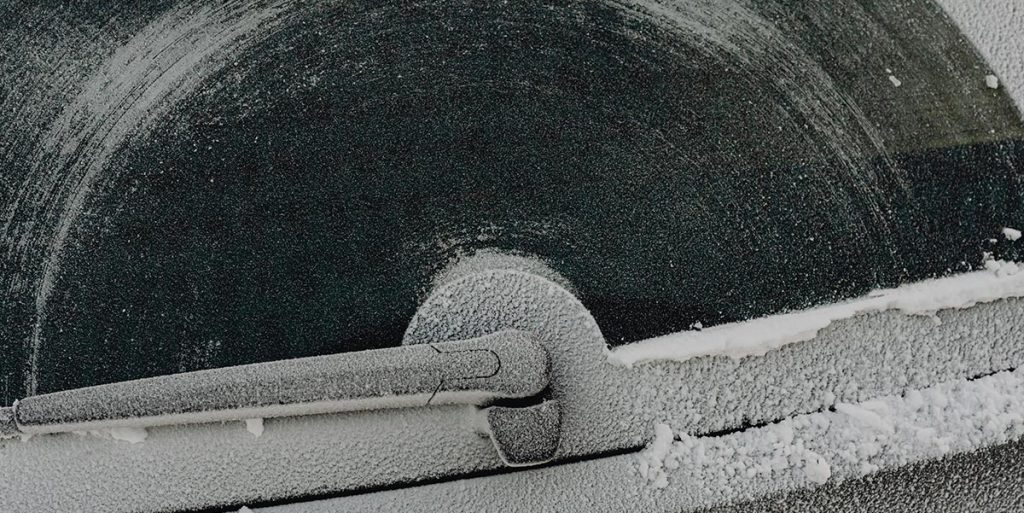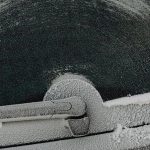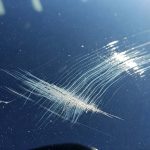
If you’ve ever found yourself running late on a winter morning, only to be met with a windshield buried under a sheet of frost, you know how frustrating and time-consuming it can be. If done improperly, scraping away ice in freezing temperatures can lead to glass damage – something we see all too often in our windshield repair shop.
Luckily, there are more innovative ways to handle winter mornings. This guide explores practical tips to help you understand how to prevent frost on your windshield overnight and avoid the daily struggle.
Why Prevention Is the Best Strategy
Trying to get ice off your windshield every morning can wear you down. The better approach is to stop the frost from forming in the first place. There are plenty of strategies, from physical covers to homemade sprays. The best part? Many of them are simple and inexpensive.
And if your glass has already suffered a crack or chip from rough scraping or extreme temperature shifts, we’re here to help with fast, affordable windshield repair and replacement services that get you safely back on the road.
What to Put on the Windshield to Prevent Ice
Let’s start with some of the most reliable methods for keeping frost from forming overnight.
Use a Windshield Cover or Barrier
The easiest and most low-tech solution is to physically block the frost. Placing a windshield cover the night before keeps ice from settling on the glass. If you don’t have a dedicated cover, try household items like:
- Cardboard
- An old towel or blanket
- A shower curtain
- Carpet remnants
Just be sure the material won’t trap moisture or freeze to the glass. Secure it by tucking the ends into your car doors or using bungee cords. Raise your wipers to help hold the barrier in place and prevent them from sticking to the windshield.
Apply Homemade or Store-Bought Sprays
If you’re wondering what to spray on your windshield to keep from freezing, there are a few DIY options:
- Vinegar + Water (3:1 ratio): Spray on a dry windshield before bedtime. The acetic acid lowers the freezing point of water and can stop frost from forming.
- Rubbing Alcohol + Water (2:1 or 1:2 ratio): Works similarly to vinegar. Alcohol evaporates quickly, making it a safe overnight option.
- Saltwater Solution: Mix one tablespoon of salt per cup of water and spray it on your windshield. If you’re wondering what you can put on your windshield to prevent ice, any of these mixtures—vinegar, alcohol, or saltwater—can act as simple yet effective barriers.
Caution: Rubbing alcohol used repeatedly could degrade the glass over time, so don’t overdo it.
Natural Alternatives
Some drivers rub half a potato or onion on their windshield. The natural oils create a thin layer on the surface that resists frost. It may not be the most conventional approach, but it works in a pinch.
How to Keep Windshield from Freezing: Strategic Parking Tips
Where you park your car can make a big difference. Try these options:
- Face East: The rising sun helps melt any ice that forms.
- Use Covered Parking: A garage, carport, or even a tree canopy can reduce exposure to open sky and keep frost away.
- Avoid High Moisture Areas: Don’t park near water sources, where humidity can increase frost risk.
If parking in the elements has left your windshield with a small crack or chip, don’t wait for it to spread. Our Burlington-based team specializes in same-day windshield repairs that help you avoid more costly replacements.
How to Keep Frost Off Windshield: Managing Interior Moisture
Sometimes the frost forms inside the windshield. That’s caused by condensation from the car’s interior.
To avoid this:
- Use the outside air setting on your ventilation system instead of recirculating air.
- Keep the air conditioner running, even with heat. This helps remove moisture.
- Empty water from mats, shake off snow before entering, and dry out wet boots.
- Place moisture absorbers in the car: silica gel packs, chalk sticks, or even a sock filled with cat litter.
- Air out the car after driving. Crack the windows for a few minutes to let moisture escape before closing everything up for the night.
- Regularly wipe down the inside of the windshield with a lint-free rag.
- Check seals and gaskets. Persistent interior frost might mean a leak that needs attention.
Additional Tools and Treatments
Aside from sprays and covers, a few other products can help prevent ice buildup:
- Water Repellent Treatments: Products like Rain-X or Aquapel® make it harder for ice to bond to the glass. Ice forms, but it’s easier to remove.
- Cold Weather Washer Fluid: Use windshield washer fluid rated for freezing temperatures (at least -25°C). You can also add rubbing alcohol to regular fluid for a DIY cold-resistant mix.
- Cover Side Mirrors: Plastic bags secured with a rubber band or clothespin can keep them clear.
- Lift Your Wipers: This keeps the blades from freezing to the windshield and makes clearing ice easier.
What to Avoid When Dealing with Frost
Some methods may seem like good ideas, but can actually do more harm than good:
| Technique to Avoid | Why It’s a Problem |
| Pouring hot or boiling water | Can crack the glass due to thermal shock |
| Using lukewarm water | Might freeze into a thicker ice layer |
| Blasting hot air at the glass | Can weaken the windshield’s structural integrity |
| Driving with a frozen windshield | Reduces visibility and is dangerous—and illegal |
Don’t rely on quick fixes that put your safety or windshield at risk.
How to Get Ice Off a Windshield Without Scratching It
For mornings when snow does fall, knowing how to get snow off a windshield without scratching the glass is important. Use a snow brush with a soft foam head or a scraper with a brass blade (better than plastic). Start from the roof and work your way down. This prevents snow from falling back onto the windshield after you’ve already cleared it.
Final Thoughts
Knowing how to prevent ice on your windshield overnight is more than a winter hack—it’s a way to protect your vehicle, save time, and avoid unnecessary stress. Whether it’s using a simple vinegar spray, parking strategically, or investing in a quality cover, small changes can make cold mornings much easier.Schedule an appointment with us today, and we’ll help you get back on the road, no matter the season!


